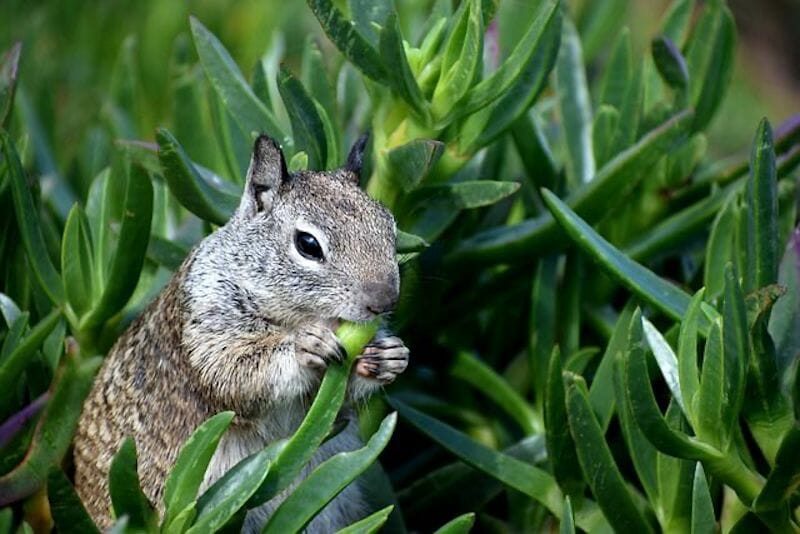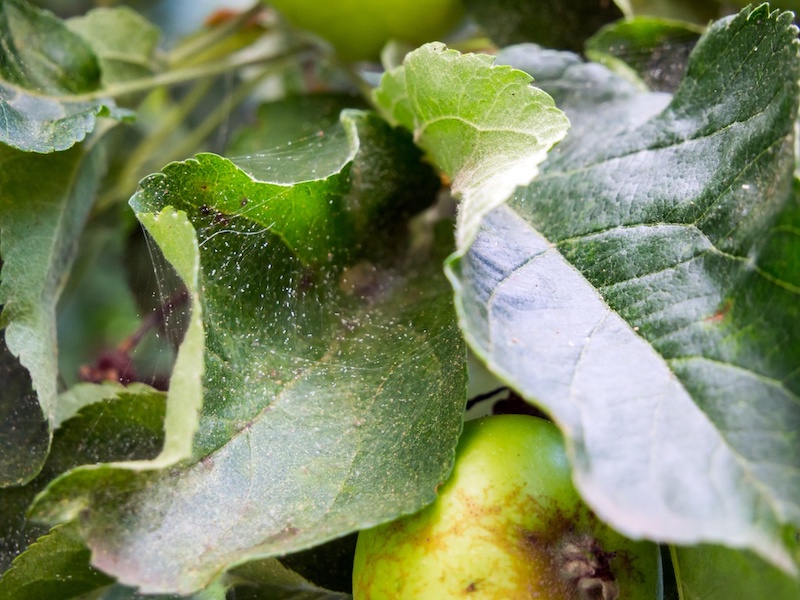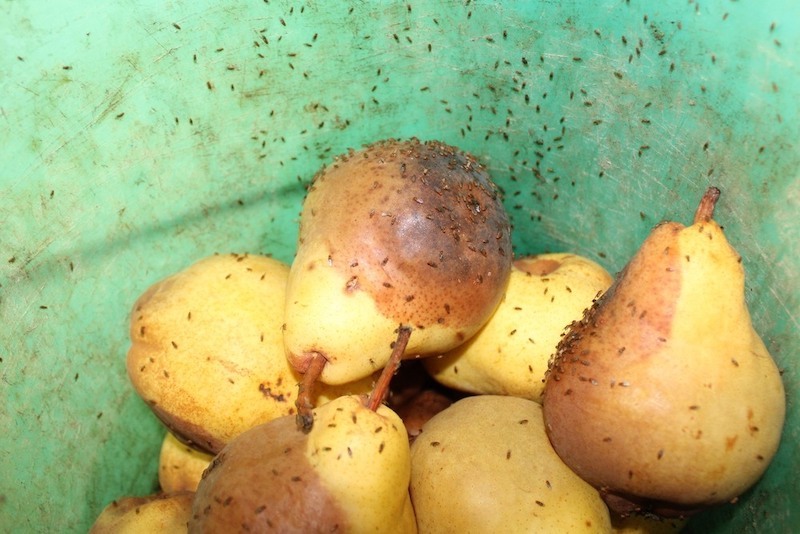Have you noticed gnaw marks, damaged leaves, missing flowers, or wilting plants? If so, you could have a pest problem. That means it’s time to act – and fast!
Here at Smith’s Pest Management, we have more than 15 years of experience in the pest control industry.
We’ve combined that expertise into this handy guide to help you learn how to identify and stop any critter that may be eating your plants.
Key Takeaways
- The types of animals that may be eating your plants include deer, rabbits, tree squirrels, ground squirrels, birds, rodents, and beavers, or insects such as caterpillars, aphids, beetles, mealybugs, spider mites, slugs and snails, grasshoppers, scale insects, whiteflies, fruit flies, or borers.
- To identify the pest that’s eating your plants, the first step is to determine what they’re eating – whether it’s flowers, leaves, or shrubs. Next, look for the signs of damage that match the damage particular animals leave. Once you’ve identified the type of pest(s) present, take appropriate control measures.
- If you need more help or your DIY efforts aren’t working, contact our team for assistance: (408) 871-6988.
How to Identify the Pests Eating Your Plants
The best way to determine the cause of the damage is to check what the pests are eating specifically and observe the type of damage they are causing.
Click the link below to go directly to the section in the blog that discusses damage to:
1. Flowers
Deer
Signs of Damage
- Plants that are torn, damaged, or missing their flowers.
- Trampled plants.
- Hoof prints and deer droppings near the impacted area.
Solution
- Install fencing (at least 5’-6’ tall) around flower beds.
- Use store-bought deer repellent sprays on the pants you want to protect.
- Plant deer-resistant flowers like marigolds and daffodils.
Rabbits
Signs of Damage
- Flowers that have been nibbled close to the ground – no more than 3’ from the soil surface.
- Stems that have been severed at a 45-degree angle.
- Small, round droppings near the affected plants.
- Shallow dig marks near destroyed plants.
Solution
- Erect a low fence, buried several inches underground to prevent digging. The fence should be at least 2’ tall and buried at least 6” underground.
- Apply store-bought rabbit repellents to the plants you want to protect.
- Use motion-activated sprinklers to scare them away.
Tree Squirrels
Signs of Damage
- Petals that have been picked selectively.
- Entire flowers that are missing.
- The presence of shallow holes about the size of a golf ball near the affected plants.
- Bite marks on remaining flower stems.
Solution
- Use hardware cloth to create a cage around the plants you want to protect.
- Plant squirrel-resistant flowers like alliums and hyacinths.
- Use summer-weight row covers to keep squirrels away from your flowers.
Ground Squirrels
Signs of Damage
- Flowers or bulbs that have been uprooted or dug up.
- Tunnels and mounds of soil around the garden.
- Chewed plants and gnawed structures, like sprinkler heads or irrigation lines.
Solution
- Install buried wire mesh or hardware cloth around flower beds.
- Introduce natural predators, such as owls, or encourage their presence.
- Apply mulch or gravel around plants to discourage burrowing.
- Set up traps – check out our comprehensive guide for more information.
2. Leaves
Caterpillars
Signs of Damage
- Ragged holes in leaves.
- Entire sections of the plant are missing.
- Droppings (frass) near affected plants.
- The presence of webbing on or under leaves.
Solution
- Hand-pick caterpillars off your plants and drop them in soapy water to kill them.
- Use Bacillus thuringiensis (Bt) spray to selectively get rid of caterpillars.
- Introduce natural predators like ladybugs and parasitic wasps.
Aphids
Signs of Damage
- Leaves that look curled, yellowed, or distorted.
- The presence of honeydew or sooty mold on the leaves of affected plants.
Solution
- Spray plants with a strong stream of water to dislodge aphids – focus on the underside of leaves.
- Apply insecticidal soap or neem oil to affected areas.
- Use horticultural oils to suffocate the aphids.
- Introduce natural predators like ladybugs and lacewings.
Beetles
Signs of Damage
- Irregular holes in leaves and petals or areas that look like they’ve been chewed.
- The presence of tiny, live beetles on or around the damaged plants.
- Leaves that have been “skeletonized” or made to look like lace – with only the veins remaining.
Solution
- Handpick beetles off your garden flowers and drop them into a bucket of soapy water.
- Use floating row covers to protect plants, especially during peak beetle activity times.
- Apply neem oil or insecticidal soap to infested plants to deter and kill beetles.
- If you notice beetles with white spots on their backs, leave them in your garden. These beetles are infested with the leaves of the Tachinid fly. When the eggs hatch, they’ll bore into the adult beetle and kill it. By leaving the infected beetles alone, you’re ensuring natural pest control over time.
- Check out our guide to beetle control for more prevention tips.
Mealybugs
Signs of Damage
- Plants that look stunted or distorted.
- Leaves that turn yellow or fall off prematurely.
- Plants have a white, cotton-like residue on the stems, leaves, or fruit.
Solution
- Regularly inspect your plants for early signs of mealybugs – pay close attention to the underside of the leaves and the soil around the base of the plant.
- Remove and destroy infested plant parts to prevent the spread.
- Introduce natural predators such as ladybugs or lacewings to your garden.
- Use insecticidal soap or neem oil to treat and control mealybug infestations.
Spider Mites
Signs of Damage
- Tiny white or yellow spots that cause leaves to look mottled.
- The presence of webbing in severe infestations.
- Leaves that turn yellow, dry out, or curl.
- Plants that look bronzed or bleached and are dropping leaves.
Solution
- Use a magnifying glass to examine the underside of leaves for the presence of spider mites.
- Rinse leaves with water to reduce spider mite populations.
- Apply miticides or insecticidal soaps specifically formulated for mites.
- Make sure your garden gets about 1” of water weekly to prevent drought stress, which makes spider mite infestation more likely.
Slugs and Snails
Signs of Damage
- Large, ragged, irregularly shaped holes in leaves and petals.
- Scalloped patterned bite marks in leaves.
- Young plants that are completely missing or have been chewed down to the stems.
- Slime trails on plants.
- Live snail sightings – usually in the evening or in damp conditions.
Solution
- Spread diatomaceous earth or crushed eggshells around the base of plants.
- Set up snail traps to attract and kill the pests.
- Encourage natural predators like birds and toads.
- Check out our guides on how to get rid of snails and how to kill slugs for more info.
Grasshoppers
Signs of Damage
- Large irregular holes in the leaves of affected plants – usually at or near the edge.
- Sightings of live grasshoppers.
Solution
- Install cones, screened boxes, or summer-weight floating row covers to protect plants (keep in mind that very hungry grasshoppers will eat through plastic row covers, so you’re better off using metal window screening to protect plants).
- Hand-pick grasshoppers and drop them into a bucket of soapy water to kill them.
- Apply biological control agents like neem oil.
- Keep a border of tall grass or lush greenery around the perimeter of your garden to draw grasshoppers away from your flowers.
3. Bushes and Shrubs
Scale Insects
Signs of Damage
- The presence of scale insects causes small, rounded or oval bumps on branches and leaves.
- Leaves that turn yellow and fall off.
- The presence of sticky honeydew and sooty mold.
Solution
- Prune and dispose of heavily infested branches and limbs.
- Use horticultural oil to smother scales.
- Introduce natural predators like ladybeetles and parasitic wasps.
- Use insect growth regulators (IGRs) to kill scales during the egg stage, or apply bifenthrin in the spring, which will kill egg-laying females.
Whiteflies
Signs of Damage
- Leaves that turn yellow, wilt, or drop off.
- Cloud of tiny white insects that fly up when you shake or rustle the plant.
- The presence of sticky honeydew and sooty mold on leaves.
Solution
- Install sticky traps designed to trap flying insects.
- Apply insecticidal soap or neem oil to affected plants.
- Encourage natural predators like ladybugs and lacewings.
4. Fruits and Vegetables
Fruit Flies
Signs of Damage
- Fruit with pitted or sunken areas on its surface.
- Fruit that drops from the plant prematurely.
- Small, discolored spots that look bruised or rotten.
Solution
- Harvest ripe fruit promptly.
- Remove fallen fruit from the garden daily.
- Set up fruit fly traps.
- Use store-bought insecticides and repellents.
- Check out our guide to getting rid of fruit flies for more info.
Birds
Signs of Damage
- Peck-marks or missing chunks in fruits and vegetables.
- Damaged or broken plants.
- Bird droppings on or near damaged fruits.
Solution
- Use bird netting or row covers to protect crops.
- Set up bird feeders far from your garden to divert their attention.
- Check out our guide for more information on how to get rid of pesky birds.
5. Trees
Borers
Signs of Damage
- Boring insects like clearwing and flatheaded borers create tunnels and holes in the bark and wood of trees.
- You may notice sawdust (frass) at the base of the tree.
- Affected trees may display dying branches and a thinning canopy.
Solution
- Water and fertilize your trees adequately to keep them healthy.
- Apply borer-specific insecticides as soon as you notice signs of boring insects.
- Remove and destroy heavily infested trees and branches.
Caterpillars
Signs of Damage
- Chewed leaves and branches that have been stripped of leaves.
- The presence of webbing on branches and leaves.
- Sightings of live caterpillars on tree bark and leaves.
Solution
- Handpick and destroy caterpillars.
- Apply Bacillus thuringiensis (Bt) to affected areas.
- Use sticky bands around tree trunks to deter climbing caterpillars.
Scale Insects
Signs of Damage
- Crusty or waxy bumps on leaves, stems, and branches.
- Leaves that yellow and drop prematurely.
- Sooty mold growth caused by honeydew secretion.
Solution
- Prune and dispose of heavily infested branches.
- Introduce natural predators like parasitic wasps.
- Use horticultural oil sprays during the dormant season.
Deer
Signs of Damage
- Stripped bark and broken branches.
- Nibbled foliage and shoots.
- Trampled ground around trees.
Solution
- Install deer fencing around the perimeter of your garden.
- Apply deer repellents to trees and the surrounding area.
- Use tree wraps or guards to protect trunks from stripping.
Rodents (Mice and Rats)
Signs of Damage
- Gnawed bark and roots.
- Small holes and tunnels around the base of the tree.
Solution
- Set up traps and baits around the trees you want to protect.
- Remove hiding spots and nesting materials around the area.
- Wrap tree bases with metal collars to prevent gnawing.
- Learn more about how to get rid of rats and mice in our blogs.
Beavers
Signs of Damage
- Gnawed tree trunks and downed trees near water sources.
- Presence of beaver lodges or dams nearby.
- Erosion and flooding due to dam building.
Solution
- Install wire mesh or tree guards around the base of trees to prevent gnawing.
- Contact a professional pest management expert for more help.
Don’t Let Pests Destroy Your Plants! Call Smith’s for Help
You’ve worked hard on your landscaping, and you don’t want pests to ruin it.
Fortunately, you’re not alone in the fight.
Here at Smith’s Pest Management, we help clients in and around the Central Coast & San Francisco Bay Area in California protect their property from all types of pests, from insects to burrowing rodents like ground squirrels. We specialize in rodent control services.






